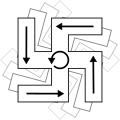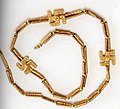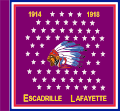Swastika

|
Legal disclaimer This image shows (or resembles) a symbol that was used by the National Socialist (NSDAP/Nazi) government of Germany or an organization closely associated to it, or another party which has been banned by the Federal Constitutional Court of Germany. The use of insignia of organizations that have been banned in Germany (like the Nazi swastika or the arrow cross) may also be illegal in Austria, Brazil, the Czech Republic, France, Hungary, Israel, Poland, Russia, Ukraine and other countries, depending on context. In Germany, the applicable law is paragraph 86a of the criminal code (StGB), in Poland – Art. 256 of the criminal code (Dz.U. 1997 nr 88 poz. 553). |

|
Legal disclaimer This image of a swastika resembles the swastika that was used by the National Socialist (NSDAP/Nazi) government of Germany or an organization closely associated to it, or another party which has been banned by the Federal Constitutional Court of Germany. The use of insignia similar to organizations that have been banned in Germany may also be illegal in Austria, Brazil, the Czech Republic, France, Hungary, Israel, Poland, Russia, Ukraine and other countries, depending on context. In Germany, the applicable law is paragraph 86a of the criminal code (StGB), in Poland – Art. 256 of the criminal code (Dz.U. 1997 nr 88 poz. 553). This ban, however, does not apply to swastikas that are of a religious nature, including ones used by Buddhism, Hinduism and Jainism. |

|
Legal disclaimer This image of a swastika resembles the swastika that was used by the Falun Gong or an organization closely associated to it, or another group which has been banned by the State Administration for Religious Affairs or General Administration of Sport of China. The use of insignia similar to organizations that have been banned in Mainland China may also be illegal in Russia and other countries, depending on context. |
Ancient Eurasian icon and later used as Nazi symbol | |||||
| Upload media | |||||
| Spoken text audio | |||||
|---|---|---|---|---|---|
| Instance of | |||||
| Subclass of | |||||
| Part of | |||||
| Depicts | Sun | ||||
| Has part(s) | |||||
| Different from | |||||
| |||||
Geometry
[edit]-
Svastika of 17 squares
-
"right-facing" swastika
-
"Counterclockwise" swastika
-
broken crossed circle
-
"Broken" solar cross
Historical
[edit]-
Seals of the Indus Valley Civilization (Mature period 2600–1900 BCE)
-
Swastika from Roman mosaic II cent. A. D. Sousse Tunisia
-
Swastika from Roman mosaic II cent. A.D. Kent, UK
-
Part of the Han dynasty "silk comet atlas"
-
Found from Nydam Mose (Nydam Bog) 200-400 A.D
-
Svastika in a Minoan pottery piece from Crete
-
ancient jewellery, at National Museum of Iran
-
Greek helmet
-
Wooden hand cross from Ukraine
-
Early Anglo-Saxon cinerary urn with swastika motifs
-
Peruvian pre-hispanic vessel from the Sican/Lambayeque culture
-
Flag of Hasekura Tsunenaga, which appeared on his ship, the San Juan Bautista
Early 20th century
[edit]Western use of the Swastika in the early 20th century
-
Scanned image of the swastika logo from a Rudyard Kipling book - a 1911 edition of Puck on Pook's Hill
-
Thanks Badge used in Scouting
-
ASEA logotype before 1933.
-
Finnish Air Force flag
-
Finnish Air Force roundel, used 1918-1945
-
Finnish army roundel, used 1941-1945
-
Flag of Utti Jaeger Regiment
-
Latvian Air Force roundel, used 1926-1940
-
Early emblem of the Mongolian Revolutionary Youth League, used 1921-1924
-
Emblem of the 45th Infantry Division, used 1924-1939
-
Kuna Yala flag (1925)
-
Kuna Yala flag (1942)
-
Early 20th century Navajo Whirling Log rug
-
Flag of the Escadrille Lafayette, used 1914-1918
-
Highlander Cross of the Podhale Rifles, pre-1945
Contemporary Eastern religions
[edit]-
unidentified Buddhist temple
-
swastika symbol on altar, Hanshan Temple, Fengqiao, Suzhou, China
-
A wall painting of Swastika incorporating animals; at a village near Coimbatore, Tamilnadu, India.
-
Decorated Hindu swastika
-
Buddhist swastika in a bronze piece in Japan
-
Swastika on building in Seoul
-
Swastika on Bulgugsa temple in Korea (1974)
-
Swastika-shaped pond at Hasedera, Buddhist temple in Kamakura, Japan
-
Swastika in a Buddhist temple garden in Sandakan, Malaysia
-
Jain swastika
-
Flag of the Red Swastika Society
-
Swastika symbol at a Xiantiandao temple in Penghu, Taiwan.
-
Kaohsiung Buddhist Hall, Taiwan.
Nazism and Neo-Nazism
[edit]
|
Legal disclaimer This image shows (or resembles) a symbol that was used by the National Socialist (NSDAP/Nazi) government of Germany or an organization closely associated to it, or another party which has been banned by the Federal Constitutional Court of Germany. The use of insignia of organizations that have been banned in Germany (like the Nazi swastika or the arrow cross) may also be illegal in Austria, Brazil, the Czech Republic, France, Hungary, Israel, Poland, Russia, Ukraine and other countries, depending on context. In Germany, the applicable law is paragraph 86a of the criminal code (StGB), in Poland – Art. 256 of the criminal code (Dz.U. 1997 nr 88 poz. 553). |
-
Nazi Swastika
-
Nazi Party badge
-
Nazi Party emblem
-
Flag of the National Socialist German Workers' Party
-
National flag of Germany 1935-1945
-
Coat of Arms of Germany 1935-1945
-
Flag of the Swedish National Swedish Party
-
Flag of the National Socialist Bloc (Sweden)
-
Flag of the National Socialist Workers' Party (Sweden)
-
Swastika on the plane Curtiss Export Hawk of Ernst Udet
-
Flag of the Order of New Templars
-
Flag of the German American Bund
-
Flag of the Dutch Nazi Party
-
Flag of the National Socialist Movement (United States)
-
Flag of the Romanian Nazi Party
-
Flag of Volksbund (Hungary)
-
Flag of Thunder Cross
-
Logo of the Russian Fascist Party
-
All-Russian Fascist Organization logo
-
Russian National Unity emblem
-
Flag of Armenian-Aryan Racialist Movement




































































